If you’re a fan of beef stews, you won’t want to miss out on our Hungarian hunter’s stew recipe. This classic dish features tender slices of beef, hearty vegetable roots, and a blend of aromatic spices that will leave you wanting more.
Today I present step-by-step how to prepare the Hungarian hunter’s stew in my version. This recipe is an explosion of flavours with a unique taste that you will surely fall in love with.
Table of Contents
Hungarian hunter’s stew, also known as “vadas”, is a traditional dish that has been a part of Hungarian cuisine for centuries.

Initially, the stew was made with wild game meat, such as venison, wild boar, or rabbit, cooked over an open fire in a cauldron. Over time, the recipe evolved to include more common ingredients, such as beef or pork and was adapted to be cooked in pots or on stovetops. The meat is typically stewed with onions, vegetable roots, and spices and served with potatoes, bread, dumplings or noodles.
Today, Hungarian hunter’s stew is considered a staple of Hungarian cuisine. It is enjoyed in Hungary, other parts of Europe, and worldwide. It is a popular dish at festivals and celebrations in Hungary.
You can find another tasty beef stew recipe here if you are interested.
Ingredients
I will use about a kilogram of beef roasting joints, which I will slice to cook faster.
I will cook the meat with a quarter of celery root, a sweet red pepper, two parsley roots, four carrots and four medium-sized onions.
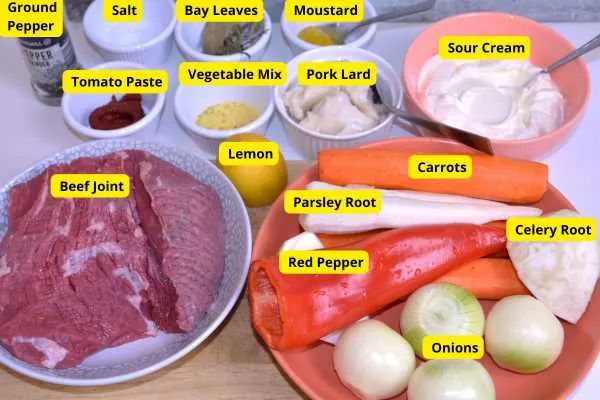
I will fry the meat and vegetables in two tablespoons of lard (or 100 ml of sunflower oil) and season the dish with mustard, bay leaves, sea salt, freshly ground pepper, dried vegetable mix and, in the end, sour cream.
Prepare the Ingredients
Let’s start with the meat, from which I cut the excess fat and sliced it into 2 cm (1 inch) slices.
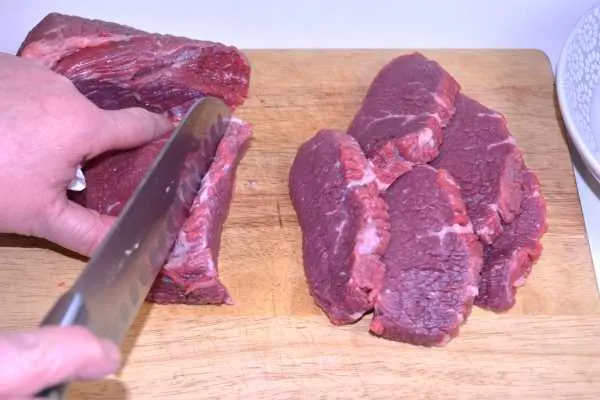
Wash the roots of the vegetable, peel them and cut them into pieces not very thin because, in the end, they will be mashed.
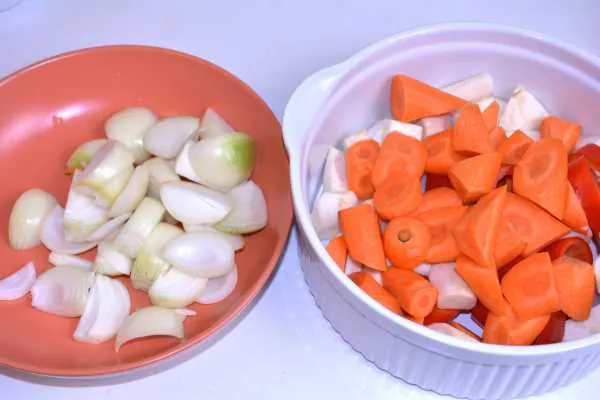
How It’s Made the Hungarian Hunter’s Stew Recipe
I will cook this dish in my favourite Dutch oven dish, where I will first melt two tablespoons of pork lard for a better taste and aroma. Of course, pork fat can be replaced with sunflower or other vegetable oils.
Fry the Beef Slices
After the lard has melted and becomes hot enough, I will fry the beef slices. I want to fry them for just one minute on each side to get a brown crust that will give them a unique flavour.
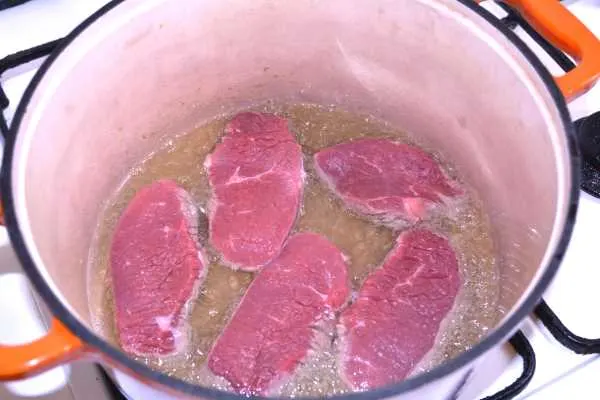
After they have been fried on medium to high heat, I turn them on the other side for another minute. Because I have a large number of slices and I want to fill the pot sparingly, I will fry them in several stages.
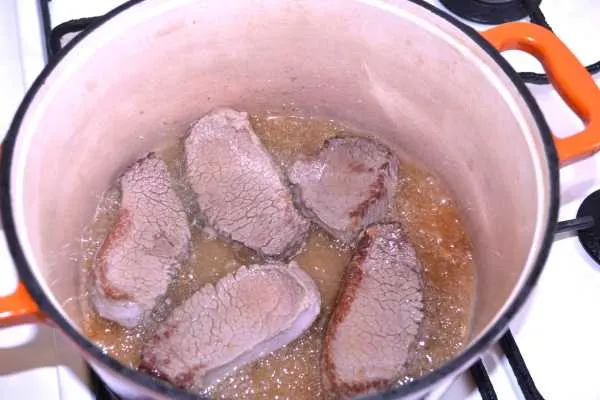
Once fried, I remove the meat slices on a plate and fry the rest of the pieces until they are all finished.
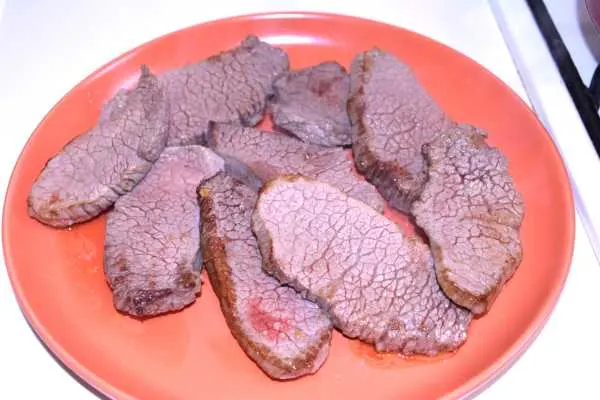
Fry the Vegetables
After I have finished with the meat, in the remaining lard in the same pot, I put the chopped onions for frying. I season them with a teaspoon of sea salt which helps remove the water content from them and saute them for about two minutes until they soften.
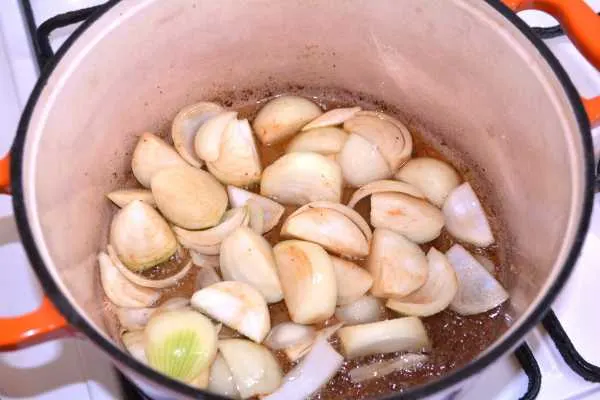
I now add the rest of the vegetables over the onion. I season them with a teaspoon of sea salt, freshly ground black pepper and a vegetable mix for soups. I add three bay leaves, sprigs of thyme, and a spoonful of tomato paste, mix them and let them sauté for another two minutes so that the vegetables get a slight crust that will intensify their flavours.
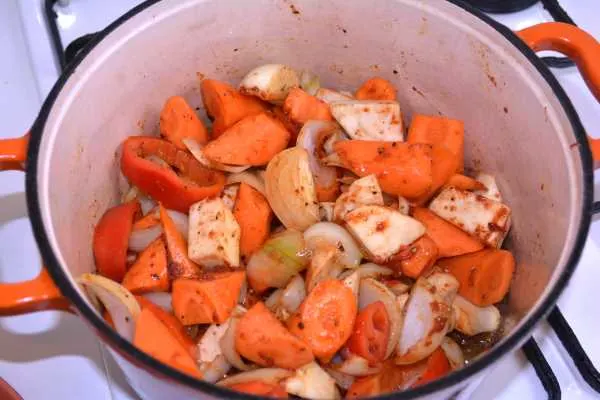
Simmering the Stew
Now you can put the fried meat slices back in the pot and pour water over them, enough to cover everything. Let it simmer with a lid at medium-low heat for one and a half hours until the meat is done.
The cooking time varies depending on the type of meat used, so I recommend that you check the texture of the meat from time to time; when it is soft and tender, it is ready.
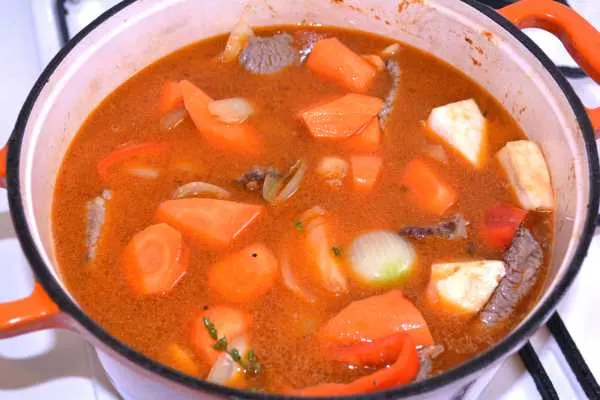
Finishing the Hunter’s Stew
After one and a half hours, I check if the meat has cooked well and take the pot from the fire. Remove the meat from the Dutch oven on a plate or bowl with a fork, and so do with the bay leaves and thyme sprigs.
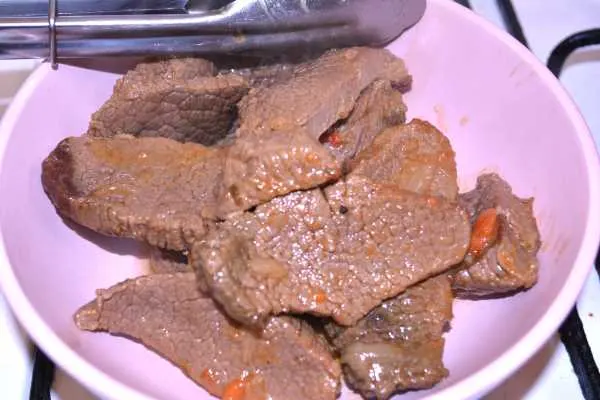
I will make the hunter’s sauce from the remaining stewed vegetables, the most essential part of the dish.
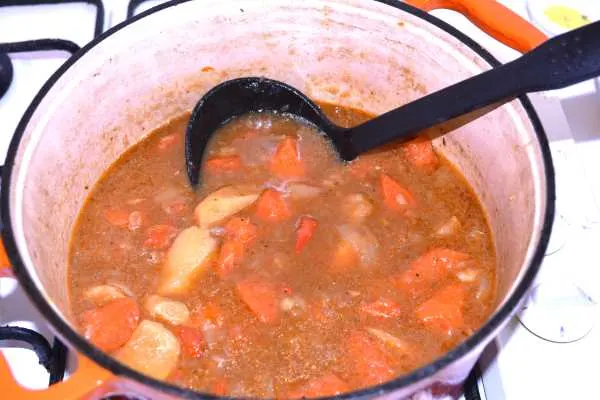
Mix the vegetables with the remaining juice with a hand blender until you get a homogeneous sauce.
Add two tablespoons of French mustard in the sauce, 300 ml of double cream or sour cream, and season with two teaspoons of sugar and half of the lemon juice. Taste, and if necessary, add more sea salt.
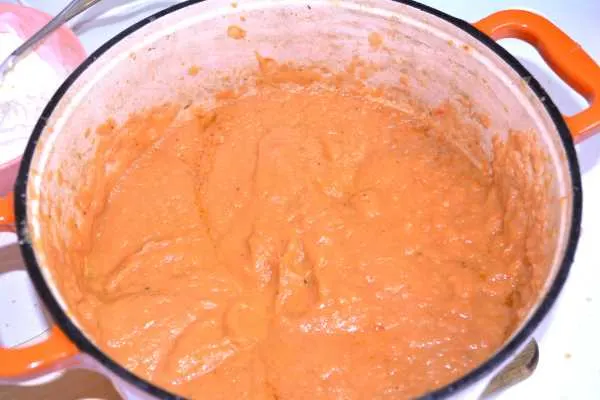
Put the meat back in the sauce and put the pot back on the fire until it boils and is ready; this is my version of the Hungarian hunter’s stew recipe; I can’t wait to serve it.
How to Serve This Delicious Dish
Usually, this Hungarian hunter’s stew is served with homemade “Hungarian nokkedli” or mashed potatoes, but I decided to serve it with gnocchi and some pickles. So delicious!
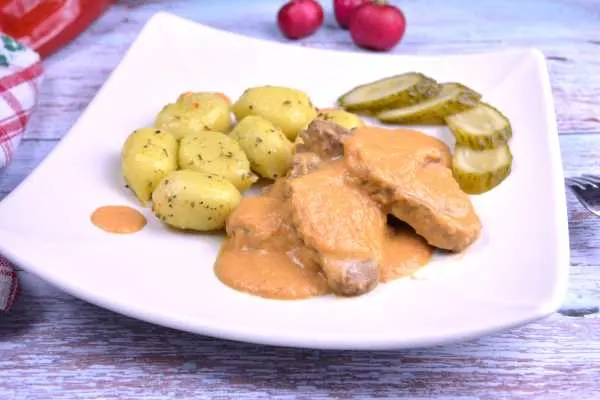
If you like my hunter’s stew recipe, you can try the following stew recipes from my blog:
- Best Lamb Stew Recipe-With Raisins and Couscous
- Pork Shoulder Stew with Mushrooms and Sour Cream
- Potatoes Stew with Smoked Sausage
- Hungarian Beef Paprikash
- Hungarian Mushroom Paprikash
- Dutch Oven Beef Stew
- Pork and Sauerkraut Goulash
- Turkey Cabbage Stew Recipe
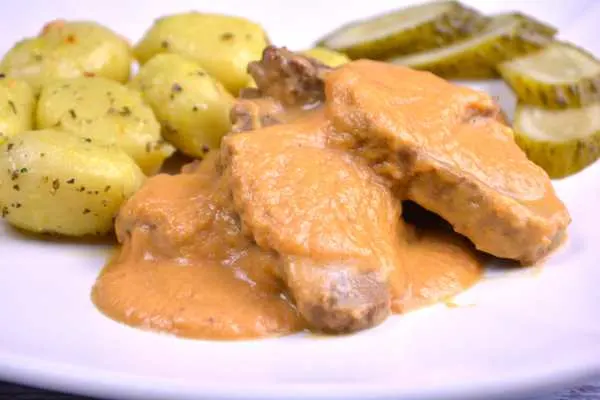
Don’t forget to follow us on our Facebook, Twitter and Instagram pages. You can pin the recipes on Pinterest or watch us cook on our new YouTube channel.
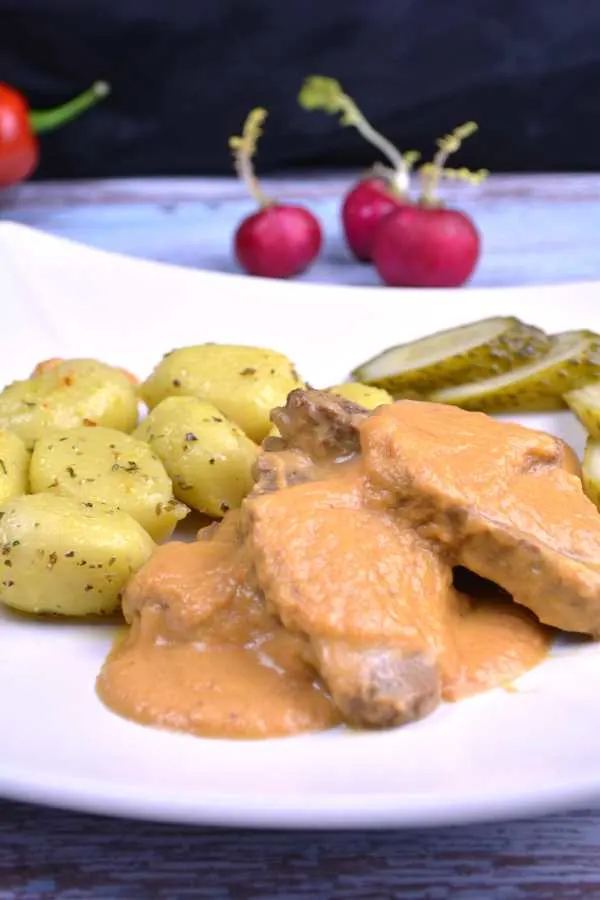
Hungarian Hunter’s Stew Recipe
Equipment
- 1 Dutch oven pot
- 1 hand blender
Ingredients
- 1 kg beef joint
- 4 pieces carrots
- 2 pieces parsley roots
- 4 pieces onions medium size
- 1 piece red sweet pepper
- 2 tbsp pork lard or sunflower oil
- 3 pieces bay leaves
- 3 sprigs thyme fresh
- 2 tsp sea salt kosher
- 1 tsp ground pepper freshly ground
- 1 tsp vegetable mix dried
- 1 tbsp tomato paste
- 2 tbsp French mustard
- 300 ml sour cream or double cream
- ½ pieces lemon juice squeezed
Instructions
- I cut the meat into 2 cm (1 inch) slices. Wash the vegetables and peel them. Cut the onions, carrots, pepper, celery and parsley roots into pieces.
- Fry the beef slices in pork lard for just one minute on each side to get a brown crust, and remove them on a plate.
- In the remaining lard in the same pot, put the chopped onions for frying. Season them with a teaspoon of sea salt and saute them for about two minutes until they soften.
- Add the vegetables over the onion; season with a teaspoon of sea salt, ground pepper, and a vegetable mix for soups. Add the bay leaves, sprigs of thyme, and a spoonful of tomato paste, mix them and let them sauté for another two minutes.
- Put the fried meat slices in the pot and pour water over them to cover everything. Let it simmer with a lid at medium-low heat for one and a half hours until the meat is done.
- Remove the meat from the Dutch oven in a bowl, and so do with the bay leaves and thyme sprigs.
- Mix the vegetables with the remaining juice with a hand blender until you get a homogeneous sauce.
- Add the French mustard to the sauce, sour cream, sugar, and half of the lemon juice.
- Put the meat back in the sauce and put the pot back on the fire until it boils.
- Serve the hunter's stew with potatoes, bread, dumplings or noodles.
Video



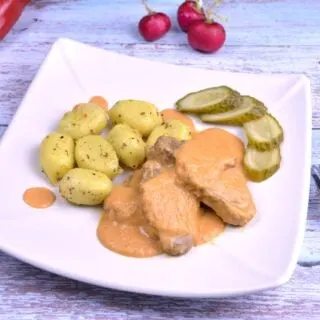
Don
Friday 3rd of February 2023
G'day from Australia. This is so close to a recipe my Nana made for my brother and I, many many years ago. But in her recipe she made a vinegar and sugar sauce to mix with the vegetable gravy which she then poured over the meat. She told us it was traditionally made by hunters with Hare, and the name was Sause-a-shoost, which translated to 'Sweet Meat'. I have tried and tried to find the recipe to cook for my family, it is one of my fondest memories of my Nana. Kind regards and stay healthy
Pete Ashford
Friday 13th of May 2022
I just love Hungarian cuisine and recipes from Transylvania. After going there on Holiday. Can't go at the moment so let's bring Hungary into my kitchen ! God Bless Pete A
Laci
Friday 13th of May 2022
Thank you, Pete!